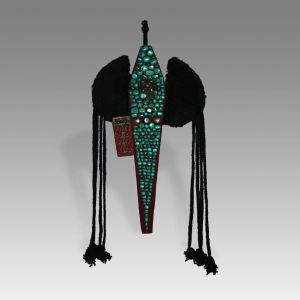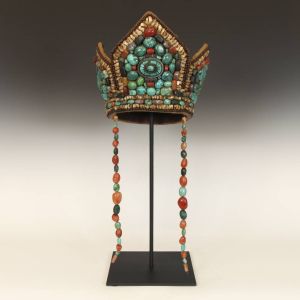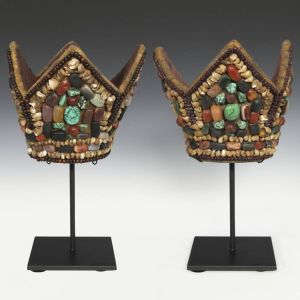 |
|
Ladakh, today a part of northern India, is an area that many people look to for both spiritual and fashion inspiration. Ladakh is actually an area in the Indian states of Jammu and Kashmir. Its culture and history are closely related to that of Tibet with whom it shares a border. When it comes to the spiritual, Ladakh is an area where a large group of Tibetans reside since it was politically demarcated from Tibet in 1942. As a result, it is a center for the practice of Tibetan Buddhism, and despite the political separation, the inhabitants have continued to look to Tibet for religious inspiration. Although austere philosophically, Tibetan Buddhism does support many rituals attendant to its spiritual practice, which leads to one striking aspect of Ladakhi fashion - the wearing of heavily ornamented headgear and costumes covered with turquoise, carnelian, mother-of-pearl, coral, and other semi-precious materials – costumes we call “Jeweled Finery.”
 |
|
Various types of headdresses are used throughout Ladakh. Most are plain; typically put together from pieces of dark fabric or leather. However, other types of spectacularly ornamented headgear also exist. The most well known is called the Perak, an unusual piece of finery covered in long rows of turquoise stitched onto the surface. Many aficionados and experts claim the Perak is the largest known form of jewelry worn in the world because of its semi-precious stone surface. The turquoise stones known as Tibetan Turquoise are trade items formerly obtained from sources in China, Tibet, and the Khotan area of Central Asia. Today, these stones are obtained from markets in India. Rows of turquoise are often enhanced by a prominent amulet box sewed onto the top center of the headdress. The outfit is further beautified by adding separate segments of decorated cloth. The Perak has stiff ear flaps and long braids made of lamb’s wool and are held in place on the owner’s head by chains or other attachments. Without question, the Perak is a cherished heirloom among the Ladakhi people, especially women.
 |
|
Traditionally, the Perak signified the wealth of the mother, which was passed along to her daughter when she married and left home to live with her husband. In central Ladakh, a traditional bride was outfitted in white bangles, amber jewelry, conch shells, a brocaded cape, embroidered shoes, silver thigh ornaments, and the Perak draped over her head. Historically, when Ladakh was a kingdom (as late as the early 1800s), the queens in Leh, the capital of Ladakh, wore Peraks with nine rows of turquoise beads to indicate their high status. Today, in Leh a woman with six or seven rows on her Perak has a lot of status. In smaller towns and villages, Peraks with five rows are marvels, and lower ranking women often have three-row Peraks. According to scholars, the Perak identifies the woman’s body with the Lu, subterranean serpentine deities that protect the human world. Since the Perak channels divine protection to humanity, their owners had to wear them at public and ceremonial functions, particularly when they visited festivals or monasteries.
 |
|
In the traditional Ladakhi belief system, jewels such as turquoise, carnelian, mother-of-pearl, and coral symbolically propitiated Buddhist deities; in essence, providing abstract representations of Buddha. Consequently, headdresses in general had important symbolic and ritual significance; so it seems inevitable that other types of head gear would become ornamented with semi-precious stones. For example, crowns and caps of multiple designs developed in the 20th century as the population of Ladakh increased due to Tibetan refugees. Their presence increased the demand for ritual adornment studded with semi-precious material. Of this material, one of the most impressive forms was a complete set composed of a crown, wrist cuffs and shoulder surround. Although it has been said Llamas wore the set with saffron robes, it is more likely they belonged to wealthy men who wore these pieces at high level functions, rituals and festivals. The development of this material during the 20th century does not automatically mean such items are “made for market,” as some people have claimed. Rather, it can be argued the internal market demand in Ladakh increased to a point where this material could also be sold to visitors.
 |
|
mother-of-pearl, seed beads, silk and cotton; PRIMITIVE I.D. #A1500-407 |
Today, only a handful of makers of jeweled finery remain; however, they are exercising creative vigor as they produce new forms that are worn by the Ladakhis themselves as well as collected by the outside world. In essence, this type of jeweled finery could be classified as fashion, or more precisely as fashion with a purpose. Yet, the real guardians of traditional Ladakhi costumes may in fact be the current generation of mothers and grandmothers, those with deep in-depth cultural knowledge about Ladakh’s costume traditions. They may be the last custodians as traditions slowly fade and elders pass on. Nonetheless, all may not be lost, for new traditions of meaningful adornment are taking root in Ladakh and being recognized by the rest of the world - sometimes as masterpieces of Buddhist adornment.